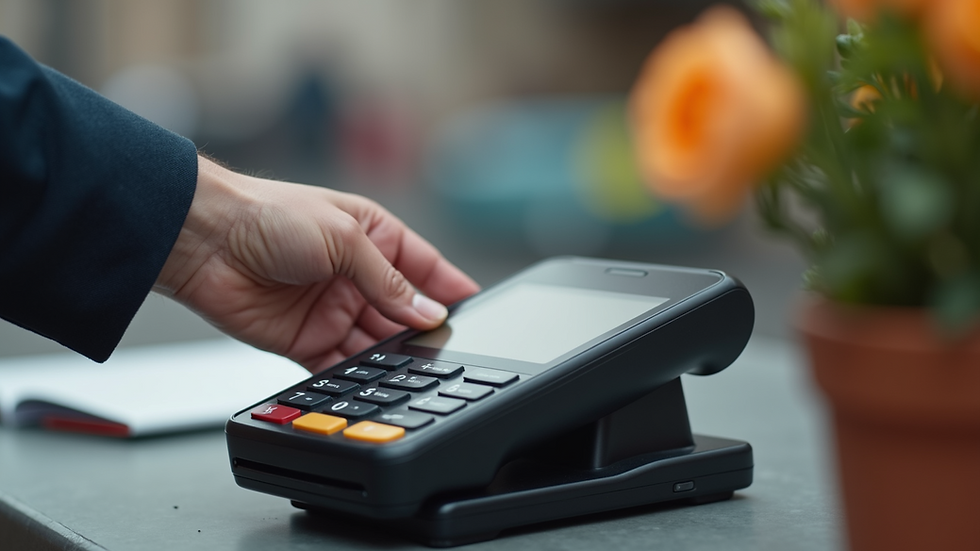How POS Terminals are Revolutionizing Transactions
- kenrod2
- Aug 14
- 3 min read
In today’s fast-paced world, the way we conduct transactions is evolving rapidly. Businesses and consumers alike are embracing new technologies that make payments faster, safer, and more convenient. One of the key innovations driving this change is the POS terminal. These devices are transforming the retail and service industries by streamlining payment processes and enhancing customer experiences.
The Growing Importance of POS Terminals in Modern Business
POS terminals have become essential tools for businesses of all sizes. From small local shops to large retail chains, these devices facilitate quick and secure payment processing. The rise of digital payments and contactless technology has made POS terminals more versatile than ever.
Businesses benefit from POS terminals in several ways:
Speeding up transactions: Customers spend less time waiting in line.
Reducing errors: Automated calculations minimize human mistakes.
Improving inventory management: Many POS systems integrate with stock tracking software.
Enhancing customer data collection: Businesses can gather insights to tailor marketing efforts.
For example, a coffee shop using a modern POS terminal can process orders and payments swiftly, allowing baristas to focus on quality and customer service rather than handling cash.
How POS Terminals Work and Their Key Features

Understanding how POS terminals operate helps appreciate their impact. At their core, POS terminals are electronic devices that process card payments by communicating with banks and payment networks. They accept various payment methods including credit cards, debit cards, mobile wallets, and contactless payments.
Key features of POS terminals include:
Multiple payment options: Chip cards, magnetic stripe cards, NFC (Near Field Communication) for contactless payments.
Security protocols: Encryption and tokenization protect sensitive data.
Connectivity: Terminals connect via Wi-Fi, Ethernet, or cellular networks.
User-friendly interfaces: Touchscreens and intuitive menus simplify use.
Integration capabilities: Sync with accounting, inventory, and customer relationship management (CRM) systems.
For instance, a retail store can use a POS terminal that accepts Apple Pay or Google Pay, catering to customers who prefer mobile payments. This flexibility increases sales opportunities and customer satisfaction.
What does POS mean?
POS stands for Point of Sale. It refers to the place and time where a retail transaction is completed. The POS system includes the hardware and software used to finalize sales, manage inventory, and track customer data.
The POS terminal is the physical device where customers make payments. It acts as the interface between the customer and the business’s payment processing system. The term "point of sale" can also encompass the entire checkout process, including barcode scanning, receipt printing, and sales reporting.
Understanding the meaning of POS helps businesses choose the right solutions to optimize their sales operations. A well-chosen POS system can improve efficiency, reduce costs, and enhance the overall shopping experience.

Benefits of Using POS Terminals for Businesses and Customers
POS terminals offer numerous advantages that benefit both merchants and shoppers. Here are some of the most significant benefits:
Faster checkout times: Customers appreciate quick service, which encourages repeat business.
Improved accuracy: Automated price calculations and tax computations reduce errors.
Enhanced security: Advanced encryption protects cardholder data, reducing fraud risks.
Detailed sales reports: Businesses gain insights into sales trends and customer preferences.
Loyalty program integration: POS systems can track rewards and discounts automatically.
For example, a restaurant using a POS terminal can split bills easily, apply discounts, and track inventory in real-time. This not only improves operational efficiency but also enhances the dining experience.
Additionally, customers enjoy the convenience of multiple payment options, including contactless cards and mobile wallets, which are faster and more hygienic than cash transactions.
Future Trends in POS Terminal Technology
The evolution of POS terminals continues as technology advances. Here are some trends shaping the future of transaction processing:
Mobile POS (mPOS): Portable devices allow businesses to accept payments anywhere, ideal for pop-up shops and outdoor markets.
Cloud-based POS systems: Enable real-time data access and remote management.
Integration with Internet of Things (IoT): Smart devices connected to POS systems improve operational efficiency.
For example, a food truck owner can use a mobile POS terminal to accept payments on the go, track sales, and manage inventory from a smartphone or tablet.

Embracing POS Terminals for a Smarter Transaction Experience
Adopting modern POS terminals is no longer optional for businesses aiming to stay competitive. These devices not only speed up transactions but also provide valuable data and security features that enhance overall operations.
If you are considering upgrading your payment system, explore the options available at pos terminal. Choosing the right POS terminal tailored to your business needs can lead to increased efficiency, happier customers, and higher profits.
By embracing the latest POS technology, businesses can future-proof their operations and deliver a seamless, secure, and satisfying transaction experience for every customer.




Comments